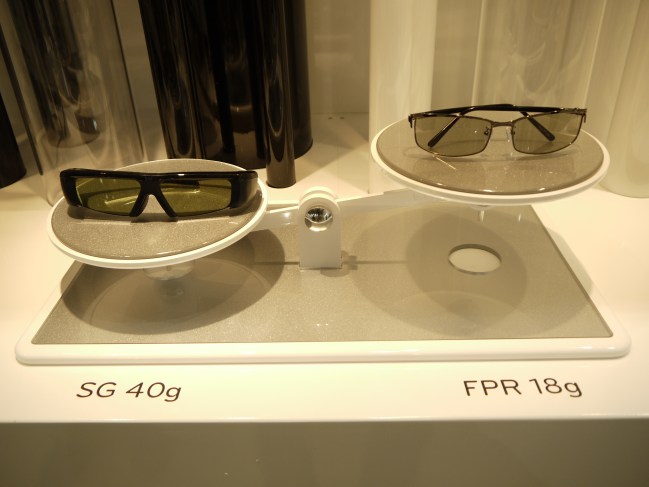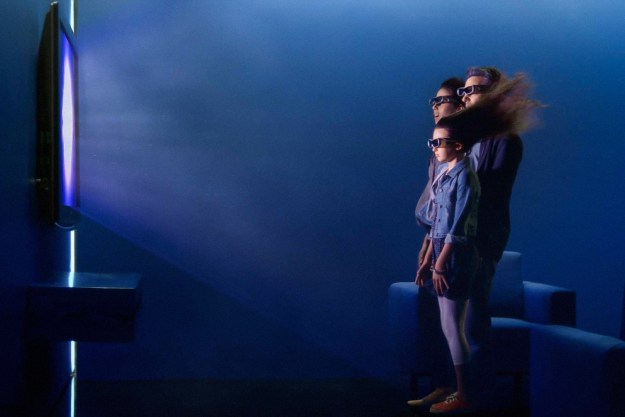 Of the many criticisms facing 3D technology for the home, the most commonly heard gripe is typically regarding the glasses. There are other complaints, to be sure, but the glasses are a major point of contention for many people. They are bulky and uncomfortable, plus they are expensive and eat up pricey batteries. Worst of all, they can cause damage to your eyes, and can make some people dangerously ill. But while the days of a practical glass-less TV for the home are still years away, LG thinks it has a solution to help ease the discomfort of the dreaded 3D glasses.
Of the many criticisms facing 3D technology for the home, the most commonly heard gripe is typically regarding the glasses. There are other complaints, to be sure, but the glasses are a major point of contention for many people. They are bulky and uncomfortable, plus they are expensive and eat up pricey batteries. Worst of all, they can cause damage to your eyes, and can make some people dangerously ill. But while the days of a practical glass-less TV for the home are still years away, LG thinks it has a solution to help ease the discomfort of the dreaded 3D glasses.
Confirming the rumors from a few weeks ago, Today at CES LG Display showed off its newest product, the film-type patterned retarded (FPR) passive 3D glasses. At first glance, the glasses simply appear to be regular sunglasses, but they are far more. Where average sunglasses are linearly polarized, these glasses use a circular polarization. If you neither know, or just don’t particularly care what that means, the result is that you can now watch 3D TV at home with glasses that do not require a battery, are much lighter, will sell for much less (although a definite price wasn’t announced, LG spokespeople confirm that each set of glasses should be under $20), and there is even a set with clips that attach FPR lenses onto the front of existing eye wear. If you wear glasses and have ever watched 3D while wearing the current style active 3D glasses, these glasses will offer a much needed respite from the weight and discomfort of wearing two pairs of glasses.
Most 3D glasses today are active shutter glasses (SG), which require batteries to process the 3D image. Unfortunately, the glasses are heavy and can be uncomfortable, and there are a few gremlins in the machine, so to speak. The two most common issues with the actual viewing of 3D with shutter glasses include the problem of crosstalk, when the images are incorrectly displayed to the wrong eye, and flicker, which can produce a light form of double vision. These problems are simply things that current 3D owners have had to learn to accept. The FPR sets will not have either problem, and the sets will also use much less energy as an added bonus.
While it may not be the 3D Holy Grail of large scale glass-less 3D, the FPR glasses are a major improvement over the existing shutter glass technology. They also cost much less. Where an SG set will cost well over $100 per pair of glasses, the FPR glasses are far less complicated, and therefore less expensive. Each FPR pair should run between $10-$20. LG would not speculate on how much each TV might cost when released in America, but they did confirm that the technology is no more expensive that the current SG 3D televisions.
LG believes that this technology is the way to go, and as such, it will soon phase out all of its 3D TVs using shutter glasses in favor of the FPR model. The FPR TVs are already available in China, and are expected in North America sometime in April, with Europe set to receive them in May. Currently, the FPR TV sets will only be available on LCD sets with projectors coming soon, but not plasma. The first round of sets will be released in sizes ranging from 32” to 55”, but smaller sets are also being considered.
Editors' Recommendations
- This 77-inch LG C3 OLED TV is $400 off at Best Buy
- 3D is readying for another comeback — and this time it’s personal
- Apple Vision Pro brings TV, 3D movies to a massive, 100-foot-wide screen
- 3D-printed eartips could mean way more comfortable and better-sounding earbuds
- Why didn’t 3D movies and TV ever catch on?


